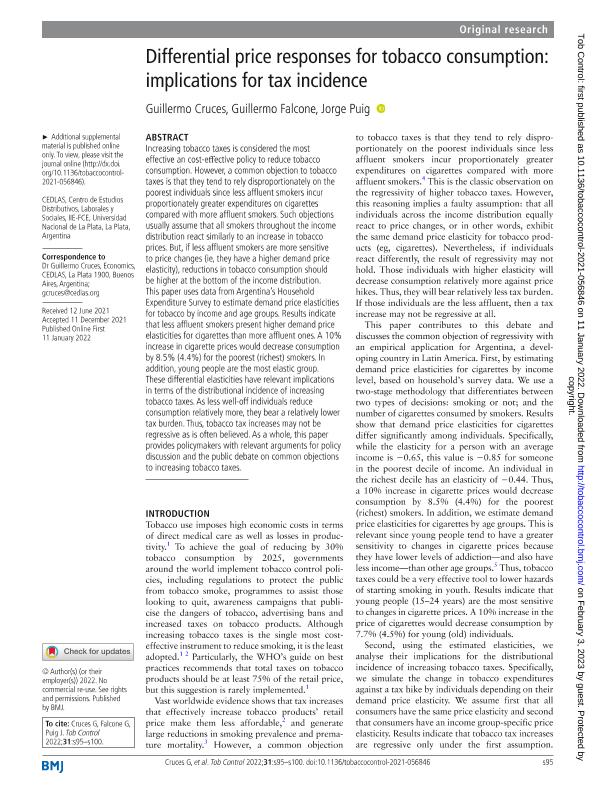Artículo
Differential price responses for tobacco consumption: implications for tax incidence
Fecha de publicación:
01/2022
Editorial:
B M J Publishing Group
Revista:
Tobacco Control
ISSN:
0964-4563
Idioma:
Inglés
Tipo de recurso:
Artículo publicado
Clasificación temática:
Resumen
Increasing tobacco taxes is considered the most effective an cost-eï¬ €ective policy to reduce tobacco consumption. However, a common objection to tobacco taxes is that they tend to rely disproportionately on the poorest individuals since less affluent smokers incur proportionately greater expenditures on cigarettes compared with more affluent smokers. Such objections usually assume that all smokers throughout the income distribution react similarly to an increase in tobacco prices. But, if less affluent smokers are more sensitive to price changes (ie, they have a higher demand price elasticity), reductions in tobacco consumption should be higher at the bottom of the income distribution. This paper uses data from Argentina's Household Expenditure Survey to estimate demand price elasticities for tobacco by income and age groups. Results indicate that less affluent smokers present higher demand price elasticities for cigarettes than more affluent ones. A 10% increase in cigarette prices would decrease consumption by 8.5% (4.4%) for the poorest (richest) smokers. In addition, young people are the most elastic group. These differential elasticities have relevant implications in terms of the distributional incidence of increasing tobacco taxes. As less well-off individuals reduce consumption relatively more, they bear a relatively lower tax burden. Thus, tobacco tax increases may not be regressive as is often believed. As a whole, this paper provides policymakers with relevant arguments for policy discussion and the public debate on common objections to increasing tobacco taxes.
Palabras clave:
ECONOMICS
,
LOW/MIDDLE-INCOME COUNTRY
,
PUBLIC POLICY
,
TAXATION
,
TOBACCO INDUSTRY
Archivos asociados
Licencia
Identificadores
Colecciones
Articulos(CCT - LA PLATA)
Articulos de CTRO.CIENTIFICO TECNOL.CONICET - LA PLATA
Articulos de CTRO.CIENTIFICO TECNOL.CONICET - LA PLATA
Citación
Cruces, Guillermo Antonio; Falcone, Guillermo Enrique; Puig, Jorge; Differential price responses for tobacco consumption: implications for tax incidence; B M J Publishing Group; Tobacco Control; 1-2022; 1-6
Compartir
Altmétricas




